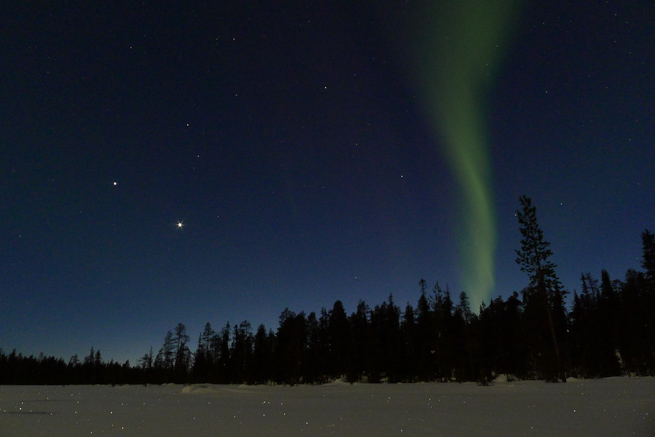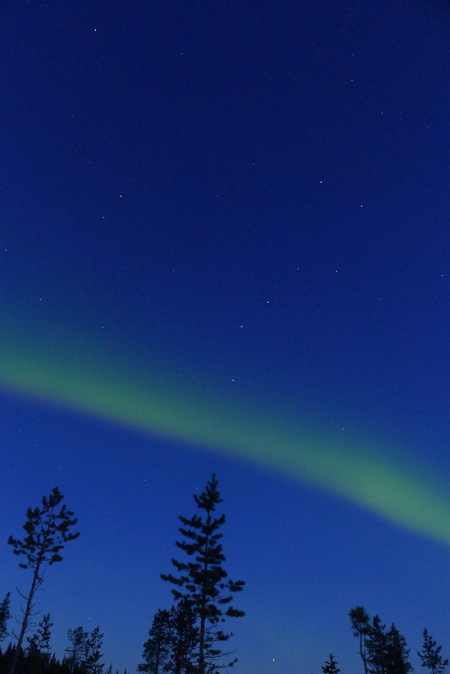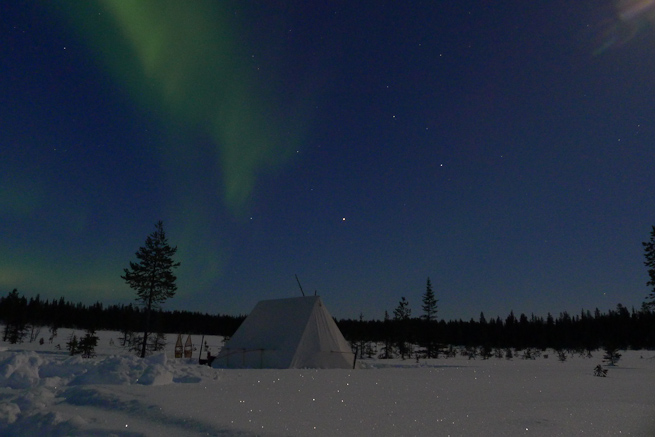The aurora borealis, or Northern Lights, are a phenomena of high latitudes.
Science informs us that the aurora are caused by solar wind interacting with the Earth’s magnetic field and atmosphere.
Long before modern science formed theories about the northern lights, indigenous peoples of the north observed their usefulness. I have heard anecdotes about aurora being used for navigation by the Sami. I have also read about Inuit use of aurora borealis for navigation.
My own personal experience also tallies with what I have heard and read.
Aurora can be either diffuse or distinct. Diffuse aurora are exactly that – a diffuse glow in the sky, sometimes almost imperceptible. Distinct aurora tend to form curtains or bands. Green is the most common colour.

Science has also observed that distinct aurora tend to be aligned in an east-west direction. The scientific explanation of this is that aurora are motivated by a specific class of magnetic field-aligned currents known as Birkeland currents. In 1908, the Norwegian physicist Kristian Birkeland deduced that currents flowed in east-west directions along the auroral arc.
This scientific observation corresponds with the observations of native peoples and the anthropologists who have studied their way of life.
In his 1969 account of life amongst peoples of northwest Alaska, Hunters of the Northern Ice, Richard K. Nelson writes:
“Several Eskimos mentioned, when asked, that the northern lights are sometimes used for navigation, because they are always oriented in bands running from east to west across the sky. Throughout the entire winter, notes were kept on the auroral orientation, usually observed around midnight. The results of this check show a monotonous regularity at this hour; the east-west orientation occurred in nearly 100 per cent of the observations, whenever there were long cohesive bands.”
This east-west orientation of auroral curtains and arcs has also been my experience while travelling and working in the north over the past 10 years.
Last month, while in the north of Sweden for several weeks, I was able to photograph a very distinct and cohesive band of aurora along with other celestial bodies. These give some directional references and show how aurora can tie in very nicely with other cues and pointers you can use for natural navigation.

This view looking westwards shows a plume of aurora seeming to emanate from the afterglow of the sunset. This photo was taken only two weeks before the March equinox and so the Sun was approaching the time it sets almost directly west. To the south of west (left in the photo), the two brightest objects in the picture are the planets Venus and Jupiter respectively. If you are regular reader of this blog, you’ll remember how we’ve noted the usefulness of observing these planets for natural navigation here and here.
Looking eastwards, the band of aurora also dropped to the horizon:

To the south of east (right in the photo), the bright and pinkish-red object is Mars. The photo was taken on March 4th, the day after the red planet reached opposition (that is directly opposite the Sun) and its brightest showing of its current apparition.
When in opposition a planet will rise around sunset and set around sunrise. It will also be at its highest point around local midnight – the exact opposite of the Sun. So, a planet in opposition just after sunset is a good indicator of east. Moreover, because this observation of Mars in opposition is near to an equinox (when the Sun rises directly east and sets directly west), it is a more accurate indicator of east than it would be at a date further away from an equinox.
You can also link the position of a planet with constellations. Just above Mars in the photo you can make out the constellation Leo. The relative position of the two is mapped out in the chart at the top of the page here.
The position of Venus, Jupiter and Mars in the sky is not fixed and knowledge of their current position requires recent observation (and memory) or the use of charts or tables.
One object we know to be fixed in the night sky is Polaris, the North Star. The most common way to find Polaris is using the well-known and easily recognised asterism, commonly called “The Big Dipper” or “The Plough”, which forms part of the constellation Ursa Major (The Great Bear).
Using the “pointer stars”, Dubhe and Merak, we can easily locate Polaris by extending an imaginary line 5 times the length of the distance between them: In the photo below, Polaris is top left. To obtain geographical north, extend a further imaginary line from Polaris down to meet the horizon at right angles. You can see in the photo how the band of aurora cuts this imaginary line approximately square on, i.e. in an east-west direction.

I was thrilled to have such a clear sky and such a distinct band of aurora to photograph. It illustrates the east-west tendency of the northern lights very well. Bands are not always as delineated or straight as the one in the photos above and the situation can be somewhat more messy. That said the east-west bias remains.

I’ve seen them many times but the aurora borealis remain an incredible and eerie phenomenon that I don’t tire of. The northern forest in winter is a spellbinding environment and the northern lights add further magic that is both beautiful and useful.
Latest posts by Paul Kirtley (see all)
- The Swedish Firesteel - January 5, 2023
- Kevin Callan and Paul Kirtley in Conversation - April 25, 2020
- Kevin Callan and Ray Goodwin in Conversation - April 18, 2020

Gary Waidson (Wayland)
We had a few nights with good displays and this directional banding was very apparent and predictable to some extent.
You can see some of the shots I took on my website if you look for the Arctic trip report in the articles section.
Paul Kirtley
Hi Wayland
Good to hear from you.
I’ve just read through your arctic trip reports. Seems like you had quite an adventure, particularly the first week you were there on your own 🙂
As always, your photos are wonderful. I hope you’ve been able to get your best camera body fixed by now? I’d be interested to know the model you borrowed from your friend.
Hope all is well with you.
All the best,
Paul
P.S. Here’s the link to Gary’s trip report pages so other readers can go straight to them.